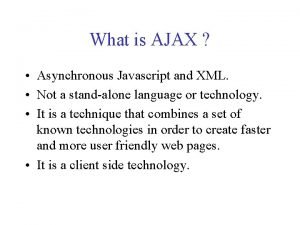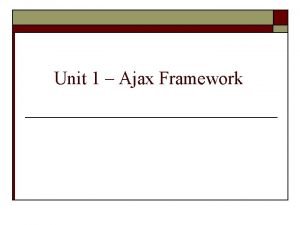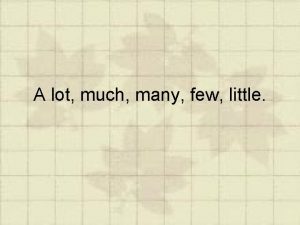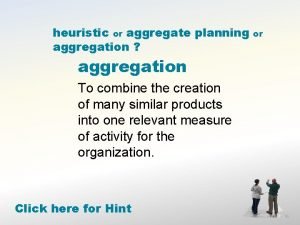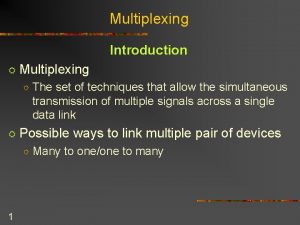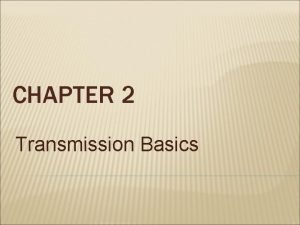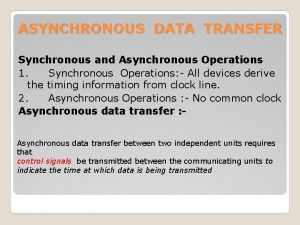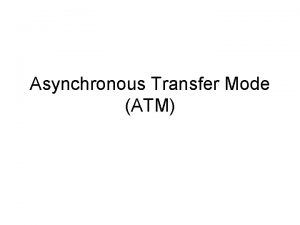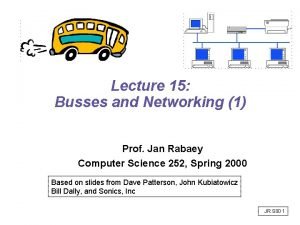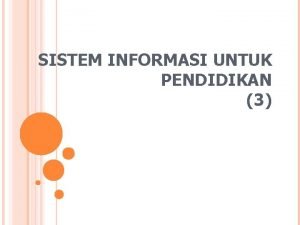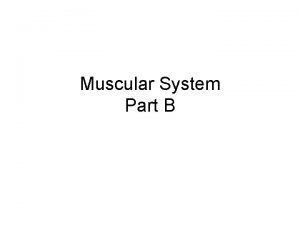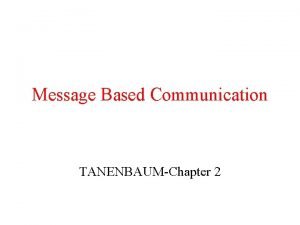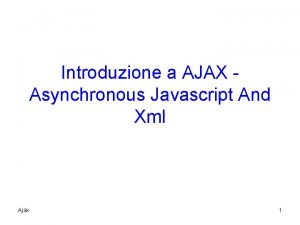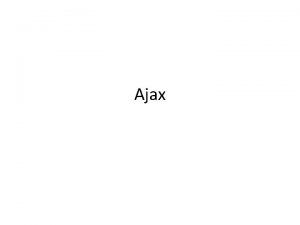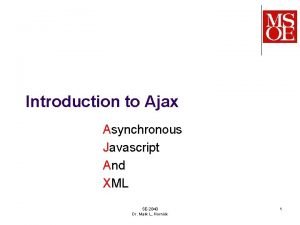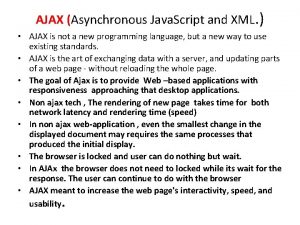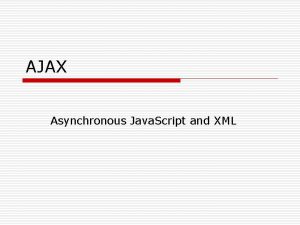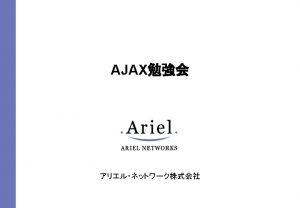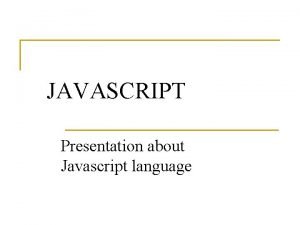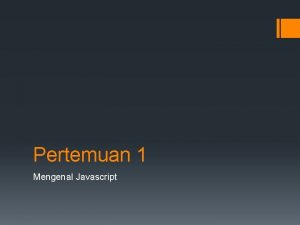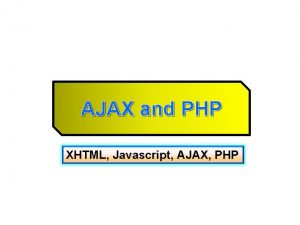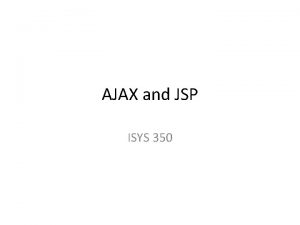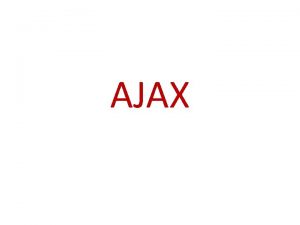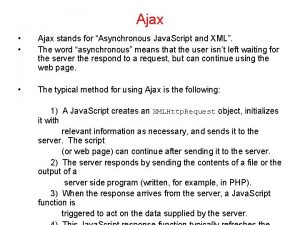AJAX Asynchronous Javascript And XML AJAX A lot























- Slides: 23

AJAX Asynchronous Javascript And XML

AJAX • A lot of hype – It has been around for a while – Not complex • Powerful approach to building websites – Think differently • Allows for more interactive web applications – Gmail, docs. google. com, Flickr, ajax 13, etc.



AJAX Technologies • HTML – Used to build web forms and identify fields • Javascript – Facilitates asynchronous communication and modification of HTML in-place • DHTML - Dynamic HTML – Additional markup for modifying and updating HTML • DOM - Document Object Model – Used via Javascript to work with both the structure of your HTML and also XML from the server

The XMLHttp. Request Object • Base object for AJAX – Used to make connections, send data, receive data, etc. • Allows your javascript code to talk back and forth with the server all it wants to, without the user really knowing what is going on. • Available in most browsers – But called different things

The XMLHttp. Request Object �script language="javascript" type="text/javascript"> < var request; function create. Request() { try { request = new XMLHttp. Request(); if (request. override. Mime. Type) { request. override. Mime. Type('text/xml'); } } catch (trymicrosoft) { try { request = new Active. XObject("Msxml 2. XMLHTTP"); } catch (othermicrosoft) { try { request = new Active. XObject("Microsoft. XMLHTTP"); } catch (failed) { request = false; } } } if (!request) alert("Error initializing XMLHttp. Request!"); } </script>

Communicating • Steps – – – Gather information (possibly from HTML form) Set up the URL Open the connection Set a callback method Send the request function get. Customer. Info() { var phone = document. get. Element. By. Id("phone"). value; var url = "/cgi-local/lookup. Customer. php? phone=" + escape(phone); request. open("GET", url, true); request. onreadystatechange = update. Page; request. send(null); }

Handling Server Responses • When the server responds, your callback method will be invoked. – It is called at various stages of the process – Test ready. State function update. Page() { if (request. ready. State == 4) { if (request. status == 200) { // Handle the response } else alert("status is " + request. status); } }

HTTP Ready States • 0: The request is uninitialized – Before calling open() • 1: The request is set up, but hasn’t been sent – Before calling send() • 2: The request is sent and is being processed – Sometimes you can get content headers now • 3: The request is being processed – The server hasn’t finished with its response • 4: The response is complete

The XMLHttp. Request Object • Methods – abort() • cancel current request – get. All. Response. Headers() • Returns the complete set of http headers as a string – get. Response. Header(“headername”) • Return the value of the specified header – open(“method”, “URL”, async, “uname”, “passwd”) • Sets up the call – set. Request. Header(“label”, “value”) – send(content) • Actually sends the request

The XMLHttp. Request Object • Properties – onreadystatechange • Event handler for an event that fires at every state change – ready. State • Returns the state of the object – response. Text • Returns the response as a string – response. XML • Returns the response as XML - use W 3 C DOM methods – status • Returns the status as a number - ie. 404 for “Not Found” – status. Text • Returns the status as a string - ie. “Not Found”

Typical AJAX Flow • Make the call – – – Gather information (possibly from HTML form) Set up the URL Open the connection Set a callback method Send the request • Handle the response (in callback method) – When request. ready. State == 4 and request. status == 200 – Get the response in either text or xml • request. response. Text or request. response. XML – Process the response appropriately for viewing – Get the objects on the page that will change • document. get. Element. By. Id or document. get. Element. By. Name, etc. – Make the changes


AJAX Response Handler function update. Page() { if (request. ready. State == 4) { if (request. status == 200) { var response = request. response. Text. split("|"); document. get. Element. By. Id("order"). value = response[0]; document. get. Element. By. Id("address"). inner. HTML = response[1]; } else alert("status is " + request. status); } }

The Document Object Model • When a document is loaded in the web browser, a number of objects are created. – Most commonly used are window and document • Window – open(), close(), alert(), confirm(), prompt() • Document – Contains arrays which store all the components of your page – You can access and call methods on the components using the arrays – An object may also be accessed by its name • document. myform. address. value = “ 123 Main” • document. myform. reset() – Can also search for element by name or id • document. get. Element. By. Id(“myelementid”) • document. get. Elements. By. Name(“myelementname”)

W 3 C DOM with Javascript • • Each xml document also has a DOM – Using Ajax you can get the returned value in xml • XMLfile = request. response. XML Parse using the DOM methods from the document. Element var root. Element = XMLfile. document. Element; document. write("The root node of the XML file is: "); document. writeln("<b>" + root. Element. node. Name +"</b>"); //traverse through each child of the root element //and print out its name for (i=0; i<root. Element. child. Nodes. length; i++) { var node = root. Element. child. Nodes. item(i); document. write("The name of the node is "); document. write("<b>" + node. Name + "</b>"); }

The Document Object • Properties – child. Nodes - returns a Node. List of child nodes – document. Element - returns the root node – document. URI - sets or returns the location of the document – first. Child, last. Child, node. Name, node. Type, node. Value • Methods – create. Attribute, create. Comment, create. Element – get. Element. By. Id – get. Elements. By. Tag. Name • Return a Node. List of all elements with a specified name

function load. Map(filename) // Download the data in data. xml and load it on the map. The format we expect is: { // <markers> // <marker lat="37. 441" lng="-122. 141" note="marker notes"/> var request = GXml. Http. create(); // <marker lat="37. 322" lng="-121. 213" note="marker notes"/> request. open("GET", filename, true); // </markers> request. onreadystatechange = function() // <trail> // <point lat="37. 441" lng="-122. 141"/> { // <point lat="37. 322" lng="-121. 213"/> if (request. ready. State == 4) // </trail> { var xml. Doc = request. response. XML; var markers = xml. Doc. document. Element. get. Elements. By. Tag. Name("marker"); mapmarkers. length=0; for (var i = 0; i < markers. length; i++) { mapmarkers. push(create. Marker(new GLat. Lng(parse. Float(markers[i]. get. Attribute("lat")), parse. Float(marke map. add. Overlay(mapmarkers[i]); } map. set. Center(new GLat. Lng(parse. Float(markers[0]. get. Attribute("lat")), parse. Float(markers[0]. get. Attribute("lng mappoints. length = 0; var trailpoints = xml. Doc. document. Element. get. Elements. By. Tag. Name("point"); for (var i = 0; i < trailpoints. length; i++) { var tpoint = new GLat. Lng(parse. Float(trailpoints[i]. get. Attribute("lat")), parse. Float(trailpoints[i]. get. Attribute mappoints. push(tpoint); } map. add. Overlay(new GPolyline(mappoints)); } } request. send(null); }

The Document Object • Go to: http: //www. w 3 schools. com/defa ult. asp

AJAX Libraries • Prototype – http: //www. prototypejs. org/ • Scriptaculous – http: //script. aculo. us/ • Jquery – http: //jquery. com/ • Mochikit – http: //mochikit. com/

Prototype Sample new Ajax. Request('/some_url', { method: 'get', on. Success: function(transport) { var response = transport. response. Text || "no response text"; alert("Success! nn" + response); }, on. Failure: function() { alert('Something went wrong. . . ') } });

Prototype Example <html> <head> <title>Testing Prototype</title> <script src="http: //www. prototypejs. org/assets/2008/9/29/prototype-1. 6. 0. 3. js"></script> <script> function get. Products() { new Ajax. Updater('products', 'products. html', { method: 'get' }); } </script> </head> <body> <h 2>Our fantastic products</h 2> <div id="products"><a href = "#" on. Click="get. Products(); ">(fetch product list. . . )</a></div> </body> </html>
 Ajax asynchronous javascript and xml
Ajax asynchronous javascript and xml Asynchronous javascript and xml
Asynchronous javascript and xml Asynchronous javascript
Asynchronous javascript What is ajax
What is ajax Put in a lot a lot of much many
Put in a lot a lot of much many Water countable or uncountable noun
Water countable or uncountable noun The lot-for-lot (lfl) rule
The lot-for-lot (lfl) rule Synchronous and asynchronous tdm
Synchronous and asynchronous tdm Difference between asynchronous and synchronous
Difference between asynchronous and synchronous Asynchronous data transfer
Asynchronous data transfer Lpc176
Lpc176 Synchronous and asynchronous i/o
Synchronous and asynchronous i/o Disadvantages of asynchronous transfer mode
Disadvantages of asynchronous transfer mode Synchronous and asynchronous bus
Synchronous and asynchronous bus System bus in computer
System bus in computer Inline internal and external javascript
Inline internal and external javascript Asynchronous sound in film
Asynchronous sound in film Asynchronous rpc
Asynchronous rpc Pembelajaran synchronous dan asynchronous
Pembelajaran synchronous dan asynchronous Pembelajaran synchronous dan asynchronous
Pembelajaran synchronous dan asynchronous Asynchronous transfer of control
Asynchronous transfer of control Asynchronous recruitment of motor units
Asynchronous recruitment of motor units Transient vs persistent communication
Transient vs persistent communication Induction generator ppt
Induction generator ppt

